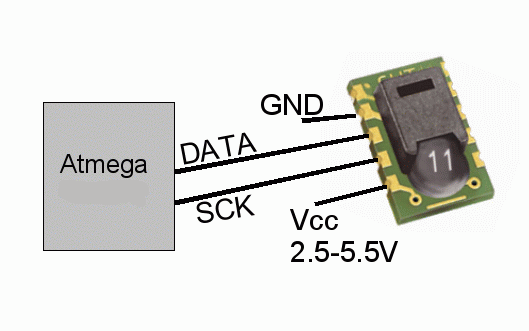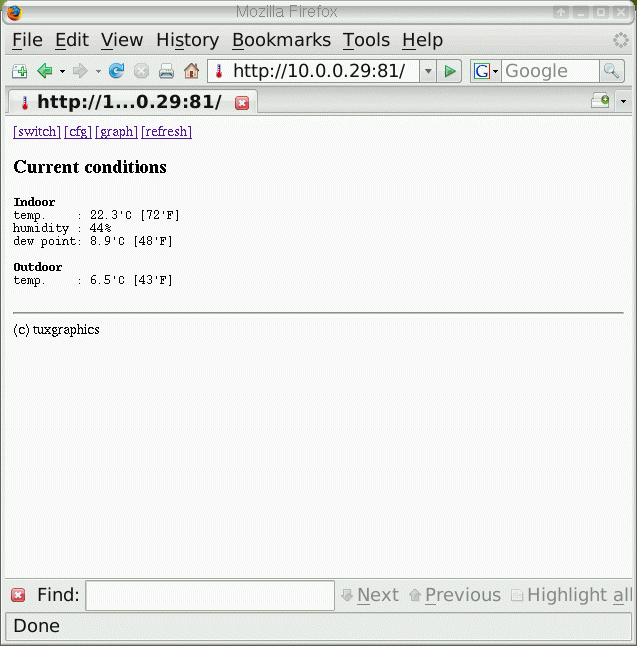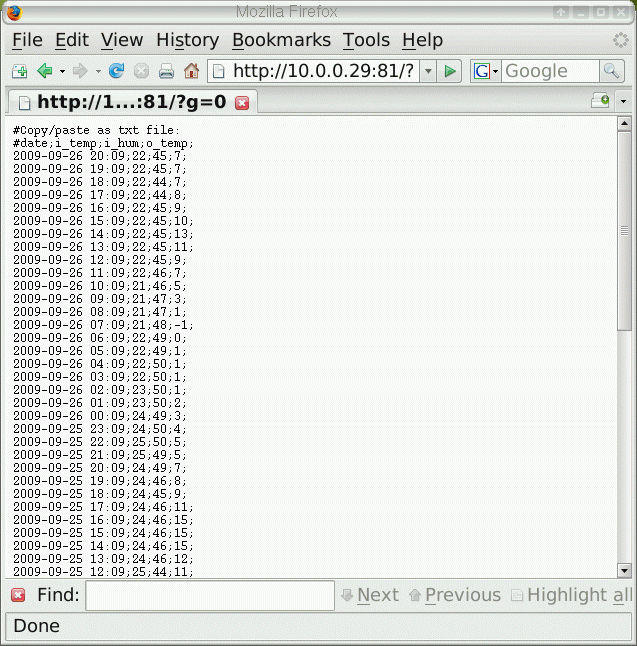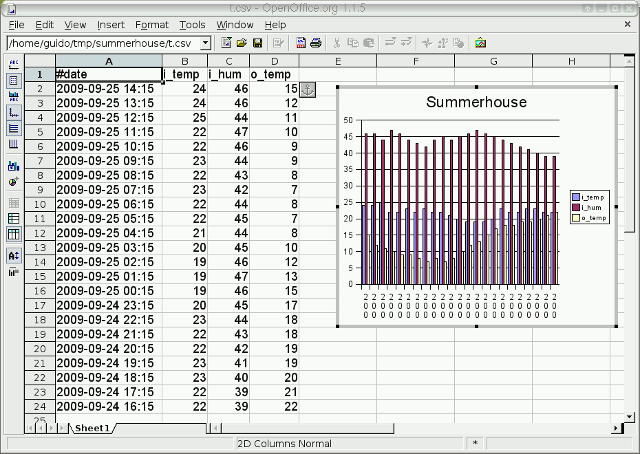![[Illustration]](http://tuxgraphics.org/common/images2/article0911/sht11-ds18s20-webserver.jpg)
This project combines the SHT11 temperature and humidity sensor together with the ds18s20 temperature sensor.
The SHT11 is ideal for indoor use. It requires a short cable length between ethernet board and sensor. It can measure temperature and humidity. Both are very important factors to maintain a comfortable and healthy climate. Nobody wants mold in the building.
ds18s20 is a very good outdoor sensor. You can have a long cable (about 10m, 33foot) between sensor and ethernet board and the sensor is fairly robust with regards to water exposure. You should keep it dry but it will survive it case it gets accidentally rained on.
There is also a new feature: the possibility to export long term measurement data into a column separated values file (CSV file) for import into a spreadsheet.
The ds18s20 is a pure temperature sensor. The SHT11 is a combined temperature and humidity sensor. The SHT11 makes it possible to accurately calculate the dew-point. The dew-point temperature is the temperature to which the air must be cooled to reach saturation. When the temperature cools to the dew point, fog or dew can occur.
Example: In your bath room you measure 23'C and 61% humidity. The resulting dew point is about 15'C. If your window or wall temperature would be 15'C or less then it would become wet.
![[circuit diagram]](http://tuxgraphics.org/common/images2/article0911/sht11-ds18s20-relay.gif)
The above circuit diagram shows how to connect the sensors to the microcontroller on the ethernet board. The two sensors are fully digital and already calibrated. A pull-up resistor is required for the outdoor sensor if the cables length is above 2m (6foot). The resistor can be soldered onto the dotmatix field of the ethernet board. The pin-out of the two sensors is as follows.

![[ds18s20]](http://tuxgraphics.org/common/images2/article0911/pinout-ds18s20-small.gif)
The circuit allows also for the connection of a relay which can then be used to switch something remotely on or off (e.g the heating).
Cable length
This solution gives you a lot of flexibility. Ethernet cables can be very long (100m, 330ft). The board can therefore be located almost anywhere in the house. There should be a short cable between SHT11 indoor sensor and ethernet board (50cm, 1.6ft). A long cable can be used between the ds18s20 outdoor sensor and the ethernet board. A cable of 10m (33ft) has been used successfully for the outdoor sensor. A 10K pull-up resistor as shown in the above circuit diagram is recommended for an outdoor sensor cable length over 2m (6ft).
Connecting to the internet
The ethernet board provides a web server with the possibility to control the relay and read the sensors. To access it remotely over the internet you will need a DSL router with port forwarding. Most DSL routers can do that.
To know where your system is you will either need a static IP address or a DSL router that can work with dyndns.org. The best and most reliable solution is to use a static IP address. Many smaller internet service providers offer static IP addresses for a small additional fee. With tuxgraphics.org/cgi-bin/checkip you can see what your current IP address is. You can use this during initial testing while you do not yet have a static IP or a dyndns.org account.
You can have more than one of those boards connected to one DSL router. All you need to do is use different port numbers.
Internal IP address and port External URL
board 1: 192.168.0.4 port 80 http://my.summer.house/
board 2: 192.168.0.5 port 81 http://my.summer.house:81/
The web pages
Here is what this solution looks like. The main window shows the current situation. On top is the menu to get to the other pages.

The relay control page allows you to switch on or off something using you password.
![[relay control page]](http://tuxgraphics.org/common/images2/article0911/screenshot-switch-2.gif)
Clicking on "graph" takes you to a page where you can see historic data plotted as a bar-graph.
![[historic data as bar graphs]](http://tuxgraphics.org/common/images2/article0911/screenshot-graph-2.gif)
Clicking on "CSV data" you can get the historic data in column separated values format for import into a spreadsheet.

The data imported into a spreadsheet.

There is also a possibility to customize the recording interval. That is: the time periods at which samples are recorded as bar graphs and data for import into a spreadsheet.
As usual all the pages are designed to work as well on basic mobile data phones. This way you have also access when you are on the road.
![[on the mobile phone]](http://tuxgraphics.org/common/images2/article0911/mobile_th.jpg)
Download section
Credit: http://tuxgraphics.org









